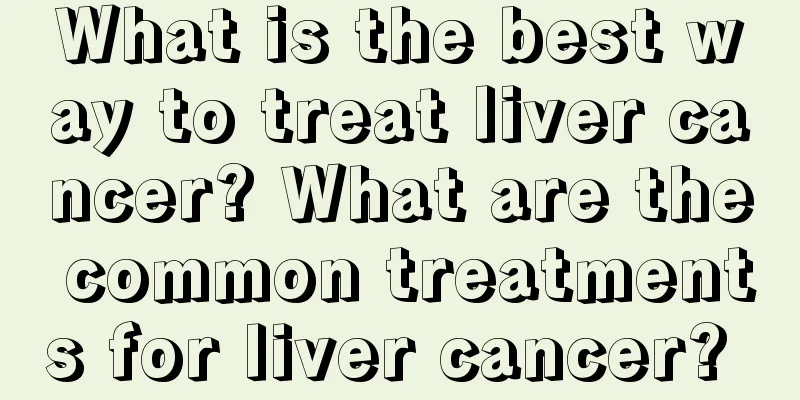What is the best way to treat liver cancer? What are the common treatments for liver cancer?

|
Treatment of liver cancer aims to eliminate the cancer, slow its growth, improve the patient's chance of survival, or control symptoms. The choice of treatment depends on whether the cancer has spread within the liver and has metastasized, the patient's overall condition and treatment preferences, and the condition of the remaining cancer-free areas of the liver. How is liver cancer treated? What are the common treatments? 1. Percutaneous ethanol injection Percutaneous ethanol injection involves injecting alcohol directly into the tumor through a simple and safe method and is particularly effective in destroying small tumors. Side effects of percutaneous ethanol injection include fever and pain after the procedure. 2. Radiofrequency ablation Radiofrequency ablation uses high-intensity radio waves or lasers through a needle inserted into the tumor, delivering enough heat to kill cancer cells. Radiofrequency ablation has largely replaced ethanol ablation. 3. Chemoembolization Chemoembolization involves injecting drugs into the liver artery that supplies blood to the tumor. The drug oil solution keeps the chemotherapy in the liver long enough to destroy the cancer cells. Chemoembolization is the main treatment for hepatocellular carcinoma, but it may also be used to slow tumor growth as patients wait for a liver transplant. 4. Radiation therapy Radiation therapy uses high-energy radiation to destroy cancer cells. Measures are taken to protect other organs from radiation exposure and treatment side effects, such as damage to the stomach and lungs. There are two types of radiation therapy used to treat bile duct cancer and hepatocellular carcinoma. Stereotactic body radiation therapy (SBRT) involves delivering high doses of radiation to the tumor while limiting the amount that reaches and damages healthy tissue. 5. Targeted therapy Targeted therapies target specific and individual genes that contribute to the growth and survival of different forms of cancer, allowing for the design of effective, more personalized treatments. Antiangiogenic drugs are the most common example of targeted therapy for hepatocellular carcinoma. These drugs work by inhibiting the formation of blood vessels, essentially starving the tumor of nutrients. For example, sorafenib is an antiangiogenic drug used to treat advanced hepatocellular carcinoma that cannot be completely removed with surgery, and its side effects include diarrhea and certain skin problems. 6. Chemotherapy Chemotherapy uses chemicals to stop cancer cells from growing, dividing, and spreading. Systemic chemotherapy involves administering drugs through the bloodstream to reach widespread cancer cells. A specific number of cycles are usually given over a given period of time, either through an intravenous line or taken orally. This is not usually used for hepatocellular carcinoma. Side effects of chemotherapy vary by individual and dosage, but include nausea, vomiting, hair loss, loss of appetite, fatigue, low blood counts, bleeding or bruising after superficial cuts or injuries, and numbness and tingling in the extremities. These usually stop once treatment is over. 7. Palliative care Palliative care aims to reduce the symptoms and side effects of treatment to improve quality of life. Palliative care can be a combination of medications, dietary changes, relaxation techniques, emotional support, and other therapies. |
<<: What are the symptoms of secondary liver cancer? How should secondary liver cancer be treated?
Recommend
How to treat a cold on the back
A cold on the back needs timely treatment. Failur...
Can recurring cervical cancer be cured?
Can cervical cancer be cured? For malignant tumor...
What are the dangers of holding urine
Holding urine is something that many people have ...
Reasons for vomiting in summer
It is generally not easy to cause vomiting in the...
What are the causes of bladder cancer?
Bladder cancer is also a common cancer disease, a...
How to wash off the oil stains on down jackets
When there are oil stains on the down jacket, we ...
Where is the best place to have heart surgery?
Nowadays, many young people feel that their work ...
90% of people have these diseases. How many of them have you been hit by?
10 symptoms 1. Eating disorder [Symptoms] The fir...
The efficacy and function of milk foot bath
Milk is a dairy product that people often drink i...
What are the methods for brain cancer examination
Tumors that grow inside the skull are generally c...
Is washing your hair with ginger water effective in preventing hair loss?
I lose a lot of hair every day. There will be hai...
What is the function of okra mucus
Okra is a relatively common vegetable and also a ...
Where can't you eat carambola
Carambola has a delicious taste, attractive color...
Does sponge contain formaldehyde
Sponges are a material that absorbs water very we...
Sweating in the middle of the night
Many people have bad living habits or hidden heal...









